Sailing in Maine - July 2008
Rick and I, and our friend Jeff, had a sailing vacation from from Southwest Harbor, Maine, from July 3-8. The destination was a real departure for me, but the mode of travel (sailing) is not, since Rick and I spend April through early November sailing out of Annapolis on Chesapeake Bay, and then manage to sneak in a sailing charter or two in the islands in between. Two years ago, Rick had done a boat delivery from Bar Harbor to Martha’s Vineyard and was completely enthralled, beginning a relentless campaign to spend a sailing vacation there. I’m a hot weather creature, but ultimately gave in.
Travel to and from Bar Harbor was easy, except for the part where we almost got killed on I-95 enroute to the airport (but that’s another story). We flew out of DCA, took the USAirways Shuttle to Boston, and a commuter to Bar Harbor. On time and relatively comfortable. We carried on, so no luggage problems.
On arrival, it was clear we were in another climate altogether. Maine feels like October in Maryland – clear, crisp and cool. The breeze off the water has a bite to it. We arrived in Southwest Harbor, which is one of the larger towns in the area, but they all have the same sort of look. Hills leading down to a snug, rocky harbor. Lobster boats and spectacular yachts on moorings. Weathered wood or clapboard buildings, with bright trim and flowers. Evergreen trees. Quaint beyond words – like a postcard really. When you add the 4th of July bunting, it’s like a Norman Rockwell painting. Except real people live and work there, and the year-round people actually can have a tough existence.

Southwest Harbor, like most other harbors we visisted during our 6-day cruise, was full of beautiful boats.
The boat we chartered was absolutely beautiful. Not the Clorox bottle white fiberglass clone-boats you usually get in the Caribbean, but a real thoroughbred – a Hinckley Bermuda 40 with a blue hull. Hinckleys, like many other “luxury” names in boats, are built in Maine. To use a car analogy, it’s like a classic Mercedes coupe restored to pristine condition, with all the latest electronics. There really are none of those mass-produced Clorox bottles in this part of the world. But the beautiful lines of the boat also mean you compromise space down below – for a nominally longer boat than ours, the one we chartered has lots less space. It was only me, DH and our friend J (who is a veteran of 5 sailing vacations, and countless OBX beach weekends/weeks, with us), so we coped, but I have a lot of dents on my skull from bopping my head on low overhangs.
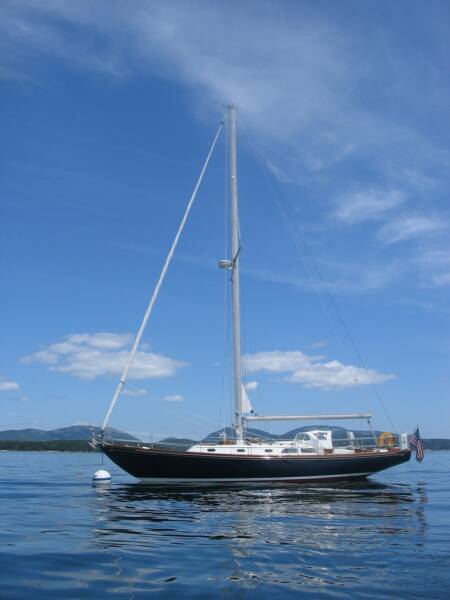
Aquarius II, hanging off a mooring ball. Rarely has a charter boat inspired so many satisfied backward glances!
Provisioning was sort of emblematic of life in this region – it’s either yuppie stuff for the “tourons” (as the locals call them), or really minimal stuff for the locals (who, I imagine, travel a long distance to find a supermarket – we just didn’t investigate it). There just aren’t any “normal” grocery stores close by, so we ordered our stuff from a gourmet grocery. Not only was the tab steep, but normal stuff like Pop-Tarts and granola weren’t available. And for the stuff I ordered, I got fancy meat and cheeses, gourmet jam to go with the PB, artisan bread instead of a regular bagged loaf, organic sausage, etc.. Most of the towns we visited had either little gourmet shops, or poorly-stocked general stores, neither of which had Doritos or Oreos. We improvised.
Restaurants (outside of the bigger towns) are pretty limited too, and our range was limited to where we could walk from any given harbor. Usually a lobster pound or a dockside seafood-oriented restaurant. You could usually get a burger, in addition to lobster (and/or local mussels and scallops) and some form of potato. Green vegetables were pretty hard to find on a menu, and even a green salad comes a la carte. I’m not a huge fan of lobster, so we only ate out a couple of nights and a few lunches. My own fancy-dancy sandwiches (made on foccacia with organic lettuce and free-range turkey breast, dontcha know) rivaled most meals we had out.
The first afternoon, we sailed through Soames Sound, which is reputedly the only fjord in North America. It’s really beautiful. It has, in many places, what they call a “bold shore” -- meaning that the water is deep right up to the high rocks that rise out of them. (We had contour charts of the area, and when the contour lines are so close together, the edges look like bold-face print.) Even thought this part of the world is absolutely littered with islands and rock outcroppings, we were able to be pretty lazy with the charts, because the boat was equipped with a chart plotter, which is kind of an overlay of GPS over the chart which shows your position, direction and speed, the depth where you are and where you’re going, notable features, channel marks, etc. We have the same exact plotter on our boat, so we were pretty familiar with it.
After the first day, we moved on to the Cranberries – Little Cranberry and Great Cranberry islands. Little Cranberry has a cute town, and they were having a town picnic for the 4th of July; we spent the night at Great Cranberry. From there, we saw a giant cruise ship leaving Bar Harbor – apparently, they have 100+ cruise ship days a year, with as many as 5,000 passengers arriving on those days. Yikes. We also could see the fireworks from Soames Sound. The sun rises early, and sets late, at this latitude, so we had to wait til nearly 9:30 for the fireworks, and we were freezing by then. Blankets in the cockpit.
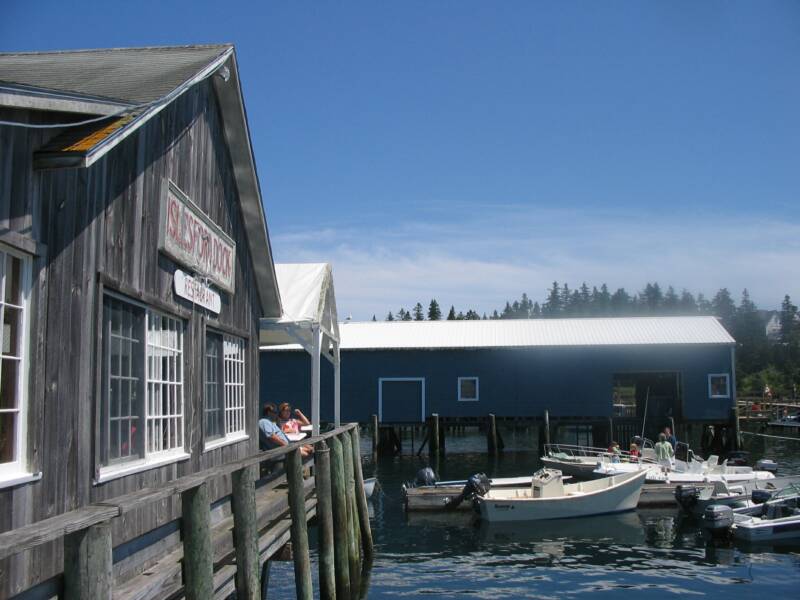
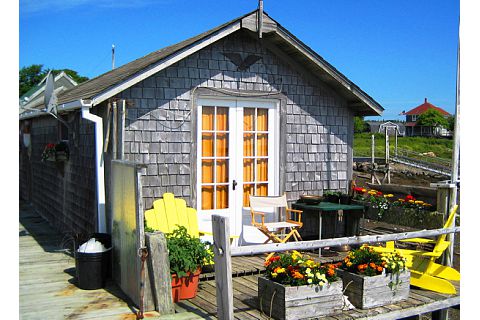
Grey shingles with accents of bright color, in both Little Cranberry and Little Cranberry Islands, are very much part of the scenery in this part of the world.
The following days were a series of sailing, mooring, and visiting harbors – where we’d get off the boat, hike around, visit lighthouses, etc. We visited Swan’s Island, North Haven, and Bass Harbor. In Bass Harbor, we bumped into a couple we know from our yacht club, who were on a 6-week trip through Maine. Small world.
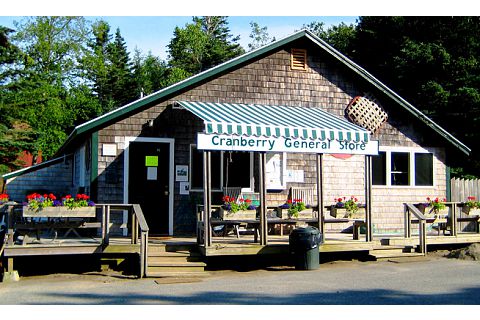
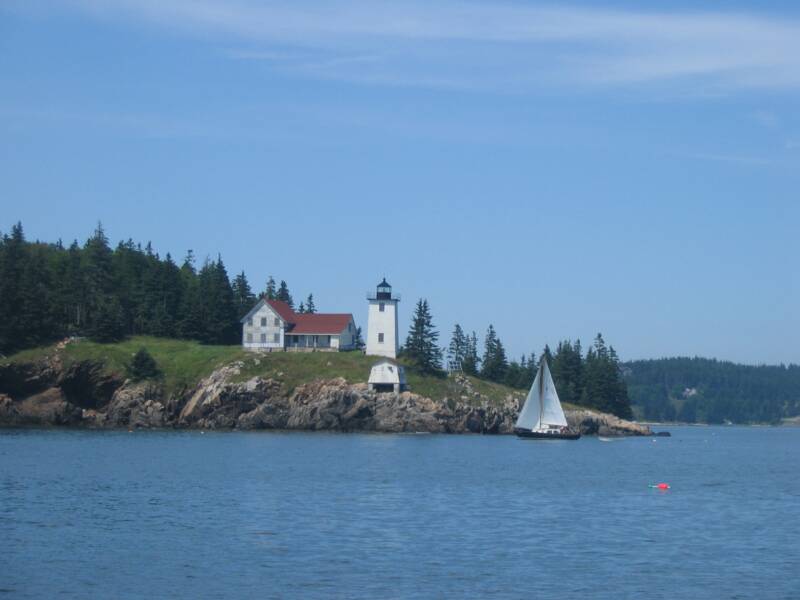

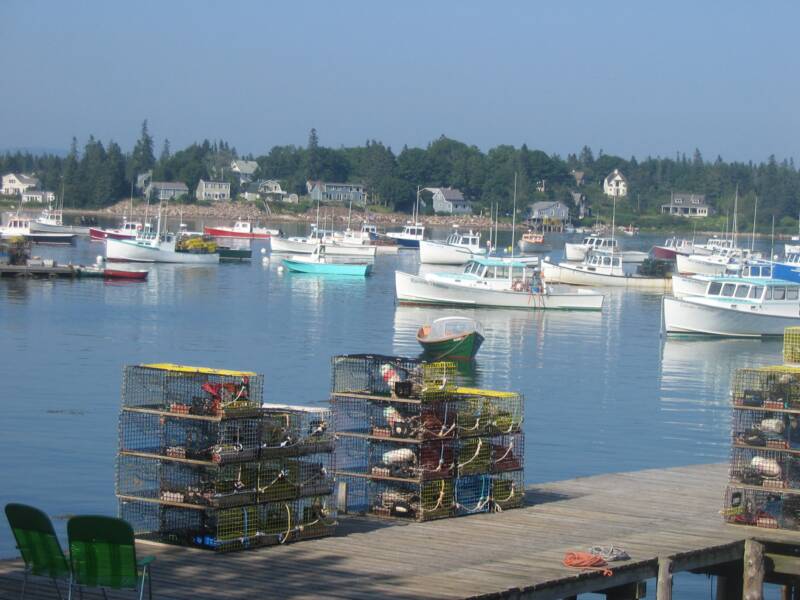
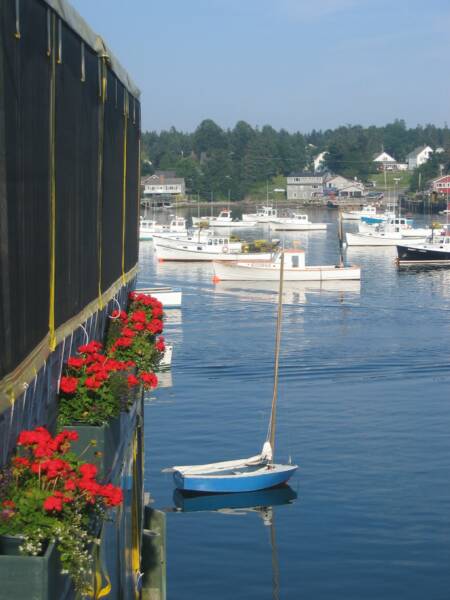
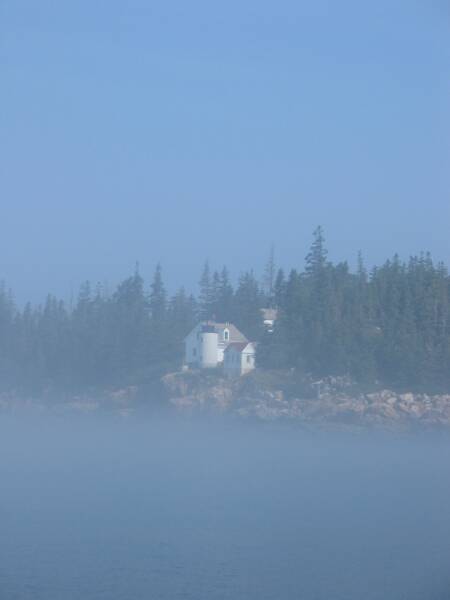
The world really shrank when the fog rolled in, which it did our third night. It’s totally unpredictable, comes and goes, and is highly localized. But when it’s thick, it totally obscures your view. It was also completely a sea feature – when you look up, you can see blue sky and sunshine, and you absolutely cannot skip the sunscreen. Since we weren’t ready to sit in one place til the fog cleared (if it ever would), we ventured into it. We relied not only on the chart plotter, but on radar. But not every vessel is necessarily a large enough presence to throw off a strong radar signal (including, possibly ours, and our radar reflector was not in very good shape), so there were a few instances when a boat on collision course, or close to it, would emerge out of the mist in just enough time to alter course. One was aptly named Brigadoon. Since boats traveling in the fog are often connecting the same dots on their plotters, it wasn’t surprising that this occurred. Luckily, every time we entered a new harbor, the fog cleared so we could see our way in. And the fog miraculously parted so we could get a good look at the emblematic Bass Harbor light.
The unpredictable fog blurs sharp edges and reduces visibility, but the right instruments and vigilance protect us from any unwanted encounters. Burnt Coat Harbor, at Swan's Island (above), and the Bass Harbor Light (right) look even prettier through the cottony haze.
Another little adventure was when we were going through the Casco Passage on our way to Bass Harbor (on Mt. Desert Island). The passage weaves its way through little islands, and at one point, a small cruise ship hailed us on the radio and warned us that we would be passing through at the same time. Luckily,
we were at a point where we could move out of the channel and let them pass unimpeded. Like that cruise ship, we found the boat people around here to be rather polite and thoughtful, unlike some of the unpleasant encounters we’ve had with watermen in the Chesapeake, many of whom clearly resent pleasure boaters.
We didn’t have to anchor anywhere on this trip, since most towns had guest or rental moorings available to visitors. Unfortunately, in North Haven, we were wakened at 1 a.m. by a sharp bump on the bow. A neighboring boat on a mooring, Isabelle, had drifted on to us. After the sort of discussion people can only have at 1 a.m., discombobulated and in an utterly fogbound harbor, we decided to gingerly move to another mooring. In the morning, we found to our relief that there was no damage to our boat, but as we departed, we saw Isabelle bumping into other boats. Clearly, that mooring was too close to others.
Sailing the coast of Maine off Mt. Desert Island is as unlike Chesapeake sailing as anything I’ve experienced. It took some time for my brain to register that there wasn’t a decimal point missing in the depth sounder readout when we routinely experienced depths of 70 … 90 … 150 feet, depths which often carried close to shore.
Bass Harbor, shown above and left, reputedly has the largerst fleet of lobster boats in Maine. We weren't likely to argue, but it was nice to see that a pretty sailing dingly was welcome here too.
Though we had one unusually windy day to start our journey, most days started calm with a southwesterly breeze building to 10-15 knots in the afternoons – sometimes in the Bay, we have stifling summer days of no wind at all except during the inevitable thunderstorms. A constant awareness of the tide state is required -- tides are 10-12 feet as opposed to
18 inches in the Chesapeake (makes me think of the “scale” comparison of real Stonehenge to Spinal Tap’s “Stonehenge”) -- since not only will water run out of shallower harbors, but the flow of the tide can help or hinder your forward motion, and currents in narrow passes can build. Unlike Chesapeake crab pots, which seem to congregate in depths of 20 feet or less, lobster traps seem to be found in all depths, and some harbors appear to be littered with confetti, as each lobsterman has a distinctively painted float (in a design registered with the state fisheries commission) and no square foot of the sea bottom seems untouched. It can be like navigating a mine field, but not impossible.
Despite my trepidation, and my overwhelming preference for hot and beachy vacations, I really enjoyed the change of scenery and would gladly do this trip again, even on our own boat, which was born in Maine as well. But not until I get some serious beach fixes!!